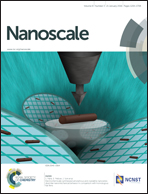Ultra-small Nd3+-doped nanoparticles as near-infrared luminescent biolabels of hemin in bacteria†
Abstract
Near-infrared (NIR) luminescent Nd3+-doped nanoparticles (NPs) have attracted considerable attention in bioimaging and biodetection. Here, we demonstrate sub-6 nm NaGdF4:Nd3+,Fe3+ NPs as luminescent biolabels of hemin molecules that act as the exogenous electron carriers in microbial communities. Contrary to the severe quenching of the visible luminescence for either upconverting or downconverting NPs, the Nd3+-doped NPs show superior properties in avoiding the optical absorption of hemin within the UV and visible spectral regions. A detailed examination showed that the Nd3+-doped NPs exhibit no obvious toxic effects on the microbial communities and show scarce influence on the characteristics of labeled hemin molecules in enhancing the reducing power of the fermentation system. More importantly, by monitoring the NIR luminescence of Nd3+-doped NPs, the selective accumulation of exogenous electron carriers in bacteria that are lacking reducing power has been revealed for the first time. The application of Nd3+-doped NPs as biolabels in bacteria would provide new opportunities for further unravelling the role of exogenous electron carriers in anaerobic digestion.


 Please wait while we load your content...
Please wait while we load your content...